Quick search
CTRL+K
Quick search
CTRL+K

Newcastle is a city in northern England, and it an interesting mix of new and old. The remains of the old castle that gave the city its name and the preserved parts of the medieval city wall are the most striking examples from history. Modern museums, well-stocked shopping malls and innovative architecture are also part of Newcastle.
Along the Tyne River there are several majestic bridges, and along the landscaped river promenade you can see some of these masterpieces from the industrial age, that added to Newcastle and northern England fame. In the same area, you can see some of England’s most spectacular buildings from recent decades.
Newcastle is close to the Scottish border, and from ancient times the impressive edifice, Hadrian’s Wall, winds its way through the countryside west of Newcastle towards the city of Carlisle. The North Sea with maritime activities at the mouth of the Tyne, churches, monasteries and beautiful nature are some of the many other things you can experience around Newcastle.
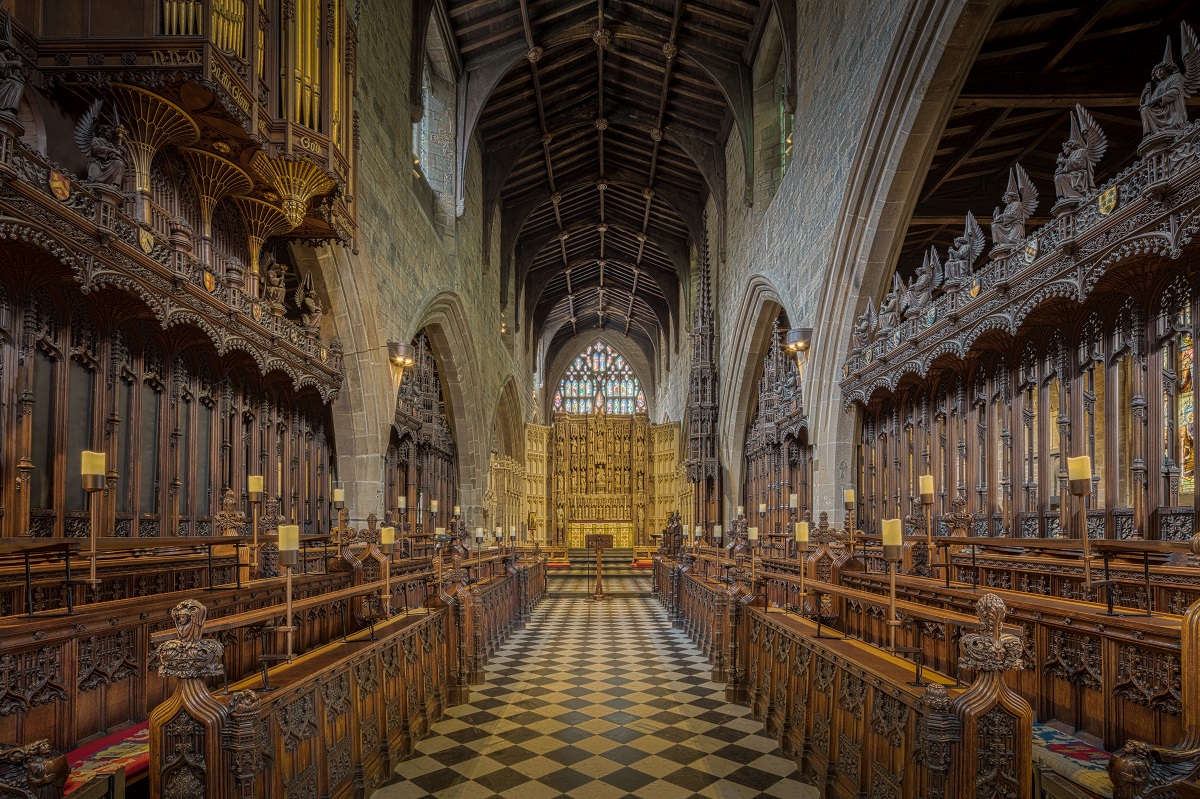
Newcastle Cathedral, formally called the Cathedral Church of St. Nicholas is Newcastle’s Anglican cathedral and thus the seat of the diocese’s bishop. The first church on the site was built in 1091, but it was destroyed by fire in 1216.
The current church was built in the 1300s, but over the centuries it has been rebuilt and extended quite a bit.
The cathedral is one of Newcastle’s most impressive buildings, with both an exterior and interior worth seeing. The cathedral is famous for its lantern spire, built in 1448, which served as a navigation point for ships on the River Tyne. On each corner of the lantern there are decorations with biblical scenes.
Newcastle grew considerably in the 19th century and many churches were built in the city. The growth meant that the parish church of St Nicholas was elevated to a cathedral in 1882, and in that connection extra was made of the interior of the church, which offers, among other things, a beautiful church room with an impressive choir.
You can see some of the furnishings created by Ralph Hedley in the early 1900s, and there are also older stained glass windows dating from the 18th century onwards. If you look, you can find exciting industrial motifs in the glass. At the other end of the time scale, St Margaret’s Chapel houses the only known fragment of a painting from the medieval church.
Newcastle Castle is the name of the castle that gave Newcastle its name. It was a castle that William the Conqueror’s son, Robert Curthose, founded in 1080. It happened on the site where the Romans had built a fort and the settlement Pons Aelius.
Curthose’s castle was a wooden fort, but Henry II built the core tower Castle Keep of stone in the years 1172-1177, and in the middle of the 13th century Henry III built the gate building Black Gate in its original version.
Today, the Castle Keep and the Black Gate are the only parts of the old castle that remain, and the Castle Keep stands as the most impressive of the buildings. The core tower is 25 meters high and 19×17 meters in plan, and there is access to both the Castle Keep and the Black Gate today.
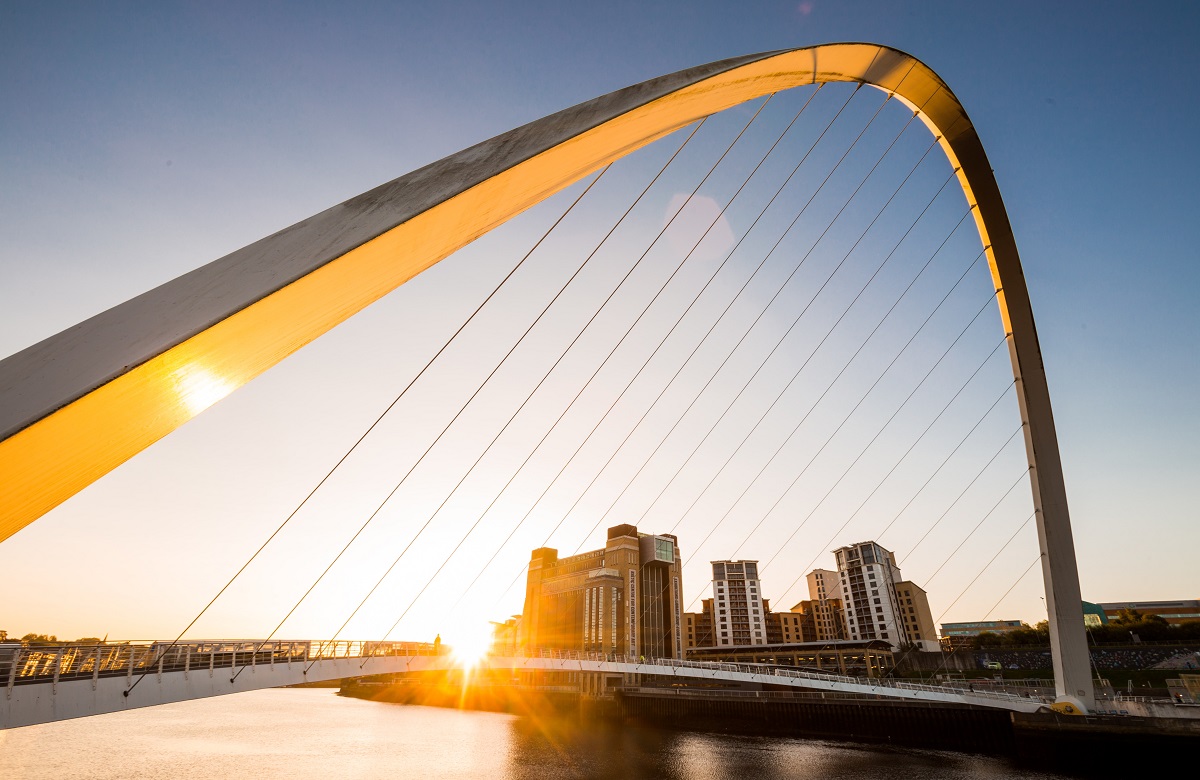
The Gateshead Millennium Bridge is one of several bridges that span the course of the River Tyne through central Newcastle. The Gateshead Millenium Bridge is a 2000 footbridge that spans an arch and was established as a modern landmark for the city.
Technically, the bridge was also interesting when it opened. It was the world’s first bridge that, so to speak, turned to open for sailing under it. The Gateshead Millennium Bridge was built with rotating fixed points at both ends, and it is an exciting sight when it rotates for ship traffic.
Grey’s Monument is a monument in Newcastle erected in 1838 in honor of Charles Grey, the second Earl Grey. The 41 meter high monument consists of a base with a tall Doric column and a statue of Charles Gray on top. Inside there is a staircase with 164 leading to a platform above the column.
Charles Gray was Prime Minister of the United Kingdom in the years 1830-1834 and Grey’s Monument was established from 1837. The column was designed by local architect Benjamin Green and the statue was prepared by sculptor Edward Hodges Baily. Around the monument you can see fine examples of Georgian architecture.
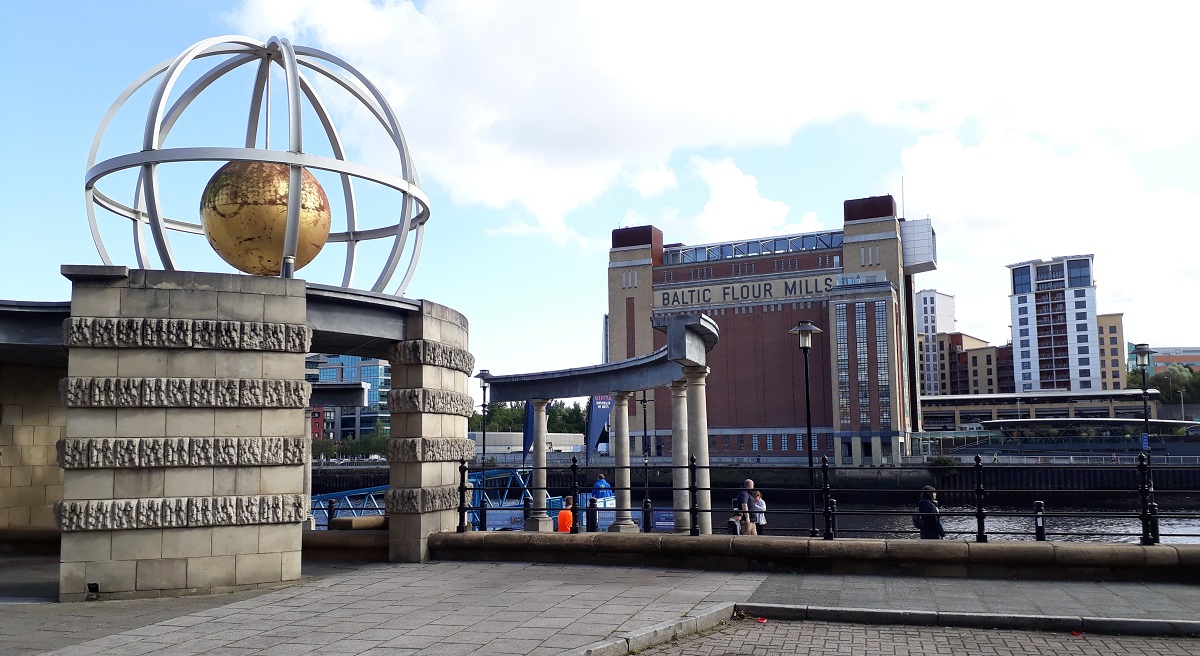
The Baltic Center for Contemporary Art is one of Newcastle’s cultural strongholds, located in the old industrial building, Baltic Flour Mills. The center has been located here since 2002, and on the many floors there is always a great variety in exhibitions and events.
Baltic Flour Mills was built by Joseph Rank from the 1930s until the completion and opening of the mill in 1950. It was a large and well-known workplace and the building could hold 22,000 tons of grain. Baltic Flour Mills closed in 1976 and the silos were used for another eight years. They then wanted to preserve the industrial landmark in the city.
The Theater Royal is Newcastle’s stately theater royal, part of Richard Grainger’s grand 1830s town plan that established Grainger Town along Gray Street as a modern part of a newly developed Newcastle.
One of the major new buildings that came to define Newcastle was the Theater Royal, designed by local architects John and Benjamin Green. The theater opened in 1837, and the first production was The Merchant of Venice.
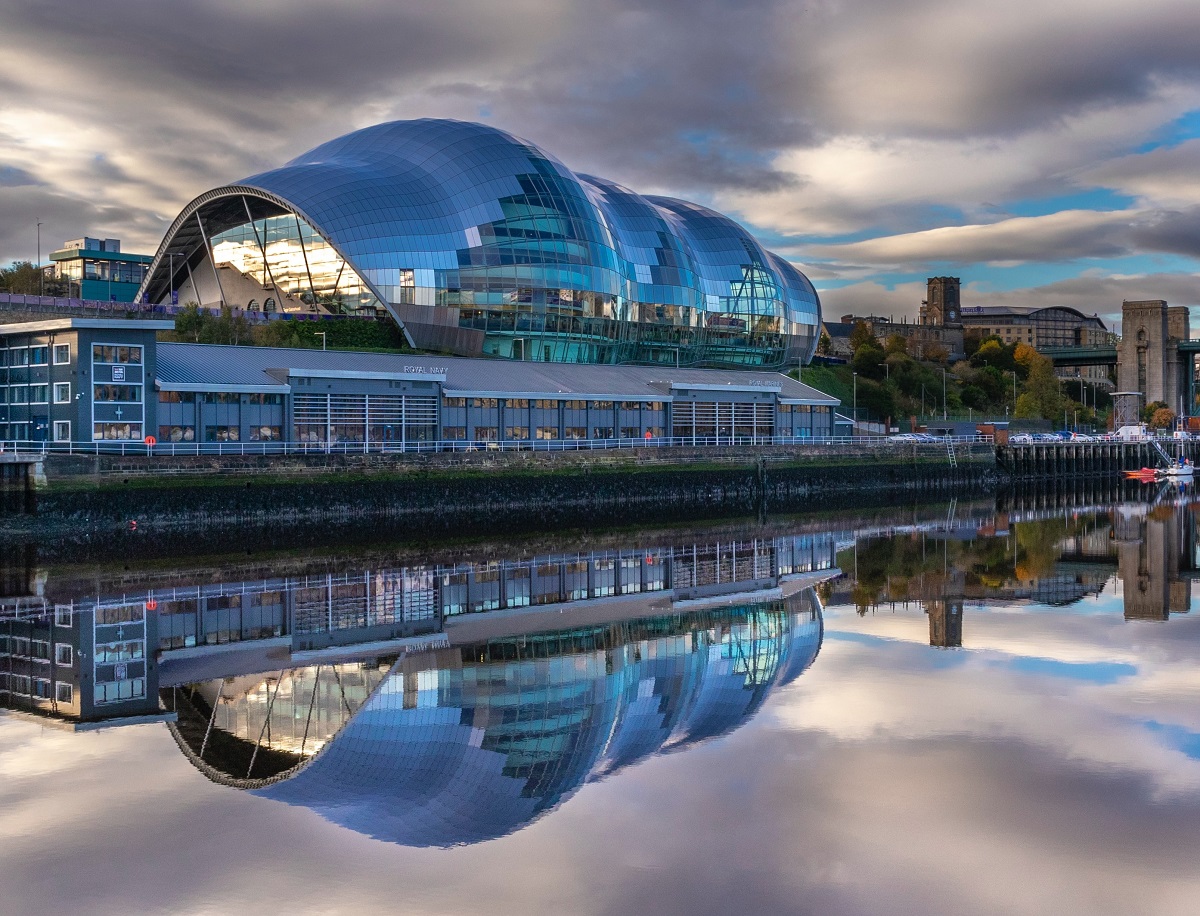
The Glasshouse is a steel and glass building that stands as a modern landmark on the south bank of the River Tyne. The building is distinctive, and its round shapes lie like one of nature’s creations and form the framework for a center for music with three stages.
The venue opened in 2004 under the name Sage Gateshead. It happened after there had been plans for a new concert hall since the 1990s. An architectural competition was launched and Foster and Partners’ proposal for Newcastle’s cultural spearhead was chosen.
Grainger Market is a series of covered market halls that were built in the 1830s, where they wanted to gather the market activities centrally in the city. Thereby, the new market building replaced, among other things, markets along Gray Street.
The market halls were designed by John Dobson and Grainger Market has two sections. The Eastern Market was a meat market that was built with long corridors, while the Western Market was a vegetable market with a large open hall.
Blackfriars is a Dominican monastery in Newcastle, founded by the wealthy merchant Sir Peter Scott in the 13th century, when various monastic orders began to come to England. The site was run as a monastery until the Reformation in the 1530s, when all monasteries were dissolved under King Henry VIII.
After the dissolution, the abbey was acquired by the city of Newcastle, who leased it to nine of the city’s lairds, who remodeled the old buildings. The Lows used the complex as a meeting place until the 1800s, when it fell into disrepair. The city bought the site in the 1950s, and the old monastery was restored between 1973 and 1981.
Today there are a few preserved monastery buildings, but the Dominicans’ church and monastery yard no longer exist. The church was demolished in the 16th century and its outline is marked in the grass in the open area. There is also an exhibition about the history of Blackfriars, workshops and a restaurant here.
Chinatown is the name of the Chinese quarter in Newcastle. The area arose when the city’s Chinese population gathered their urban life over time around the streets that today make up the city’s Chinatown, and in this area there used to be a monastery.
At the northern entrance to St. Andrew’s Street you can see a traditional Chinese portal that has stood as a symbol of Chinatown since 2004. From here you can take a walk in the district and along the main street Stowell Street, at the southern end of which you can see a preserved part of Newcastle’s old city wall.
Newcastle Town Wall is a medieval town wall that was built in the 13th and 13th centuries as protection for the city during troubled times. The wall was up to 7.6 meters high and over 2 meters thick in its approximately 3 kilometer length around what was then Newcastle.
There were six gates in the city wall, the Close Gate, the West Gate, the New Gate, the Pilgrim Gate, the Pandon Gate, and the Sand Gate, and in addition there were seventeen towers. The wall came into use, and in the middle of the 17th century Scots managed to penetrate it during the English Civil War.
Newcastle’s city wall had become redundant in the 18th century, and over time large parts of the wall were torn down in connection with the city’s natural development. However, a large preserved section of the western wall can still be seen in and around W Walls, Stowell Street and Orchard Street.
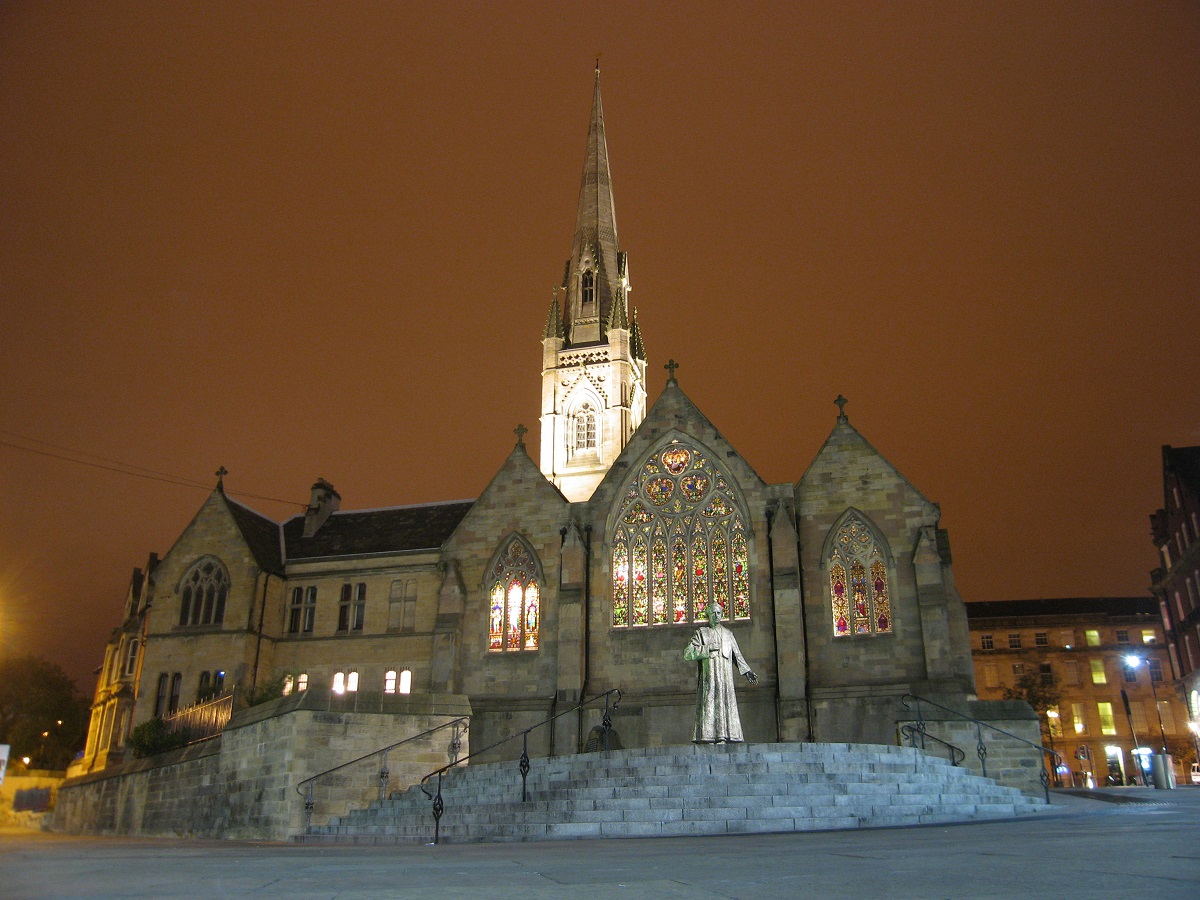
The Cathedral Church of St Mary or simply St Mary’s Cathedral is Newcastle’s Roman Catholic cathedral. As a cathedral, the cathedral is the seat of the Bishop of Hexham and Newcastle, and it gained that status in 1850 as the first church in Newcastle.
The cathedral was built in the years 1842-1844 by the architect Augustus Welby Pugin, who is known for several Neo-Gothic buildings such as the Elizabeth Tower and the interior of Westminster in London. It was also Pugin who designed the church’s mosaic windows, which were produced by William Wailes in 1843.
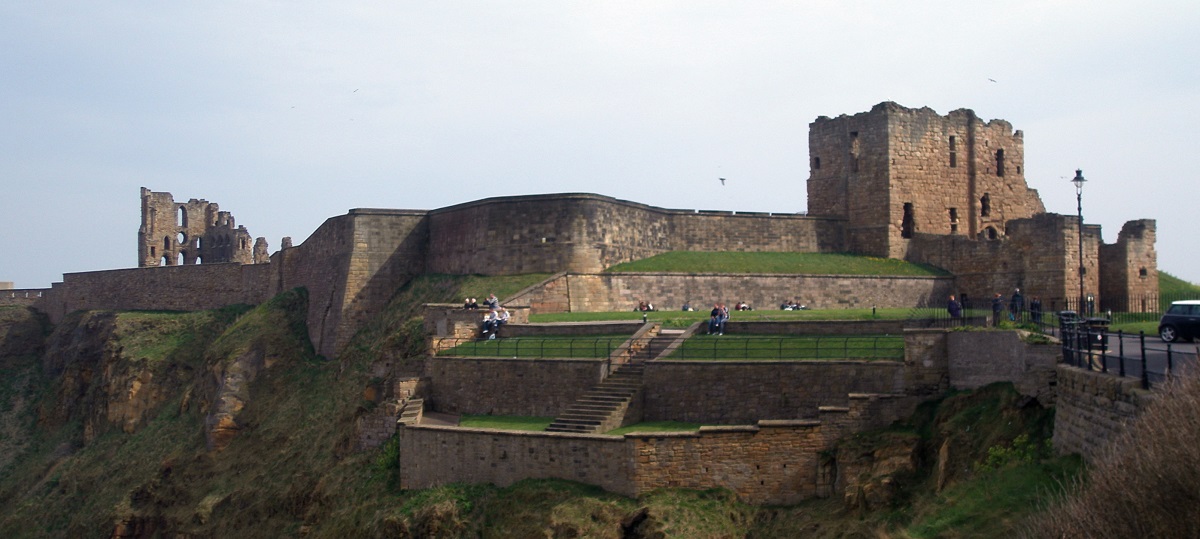
Tynemouth is a town located at the mouth of the River Tyne in the North Sea and thus a few kilometers from Newcastle by water. There has been a settlement since the Iron Age at the strategically important site, and possibly the Romans may also have been in the area. In the 6th century, a monastery was established here, which was later both fortified and attacked by Danish Vikings.
The beaches at Tynemouth became popular bathing spots from the 18th century, and today you can still see many beachgoers at Tynemouth Longsands in season. On a trip to town, you can also take a walk along the main street, Front Street, where to the east is a statue of Queen Victoria, and which leads to the sea to the west and the ruins of Tynemouth Castle and Priory, which sits on a rocky outcrop in the North Sea .
It is with good reason that Tynemouth Castle and Priory is the town’s biggest attraction. It is a large site where you can see fortifications such as moats, castle towers and a gatehouse along with the ruins of the Benedictine monastery where the early kings of Northumbria were buried. Tynemouth’s town arms still contain three crowns for the three kings who were buried here.

Sunderland is a regional metropolis, at the mouth of the River Wear facing the area’s beautiful North Sea coastline. Historically, there were three settlements on the river estuary, which later formed today’s Sunderland. It was Monkwearmouth from 674 on the north bank and Jarrow from 684 and Bishopwearmouth from 930, both on the south bank of the river.
Fishing provided prosperity for urban development, as did the port facilities along the river. Sunderland obtained city rights in 1179, and trade in coal and salt arose with ships built locally on the river. The 19th century growth from the port and industrialization caused the three original towns to be formally merged.
Angel of the North is a modern sculpture that stands in the landscape south of Newcastle and west of Sunderland. The great angel was created by the British sculptor Antony Gormley and completed in 1998. The angel was made of corten steel and measures 20 meters in height and a whopping 54 meters in width. Corten steel has a special alloy that gives the angel an oxidized appearance.
It was the Metropolitan Borough of Gateshead council that in 1990 devised a plan for a sculpture as a new landmark for the area. In the process, Antony Gormley was selected for the task, and when he had seen the location for the desired sculpture, he agreed to the task. It is also clear from a visit today that the Angel of the North dominates the surrounding landscape and thereby stands as a powerful symbol.
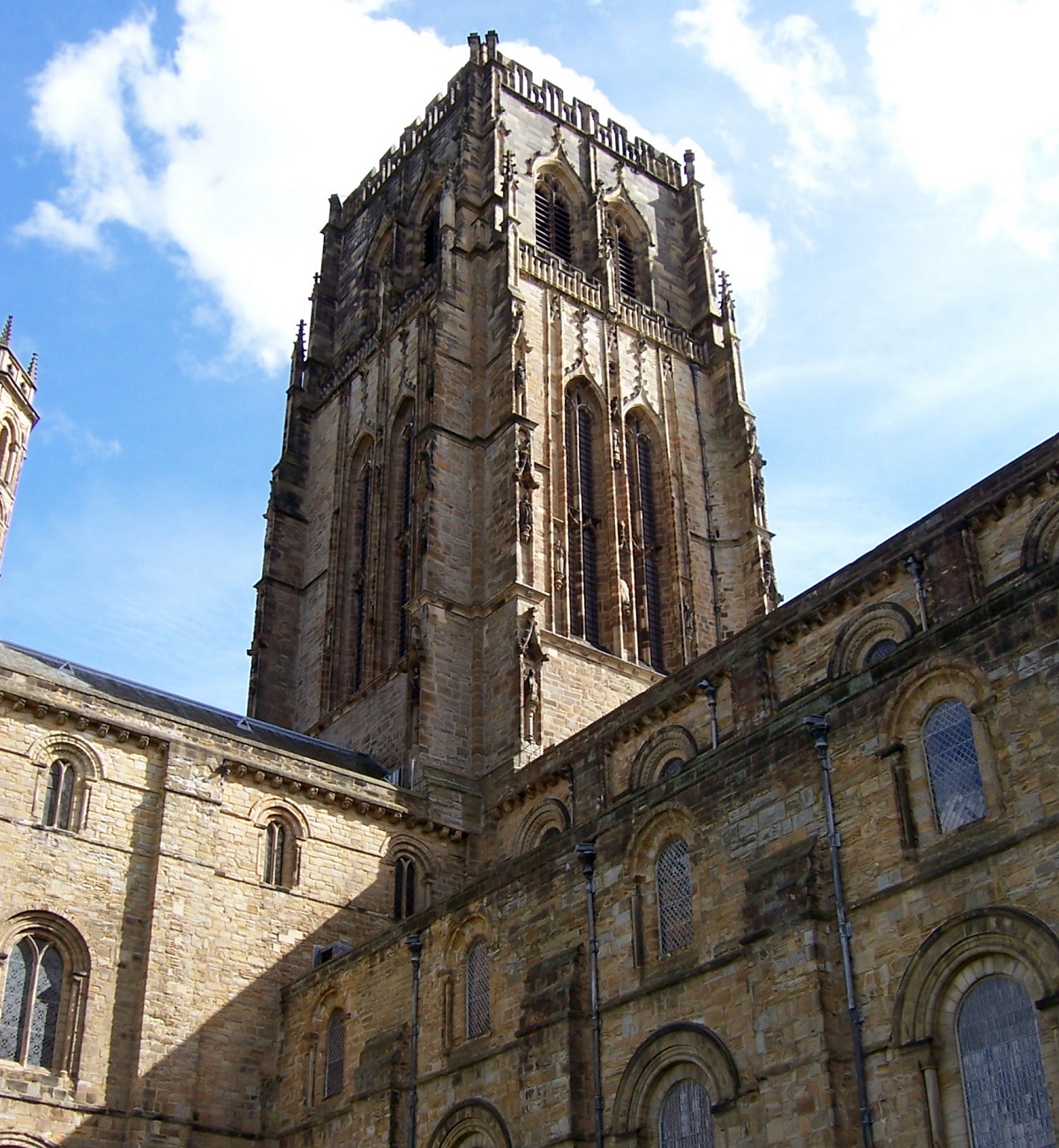
Durham is a city beautifully situated on the River Wear, and just where it makes a bend, the historic town center is on a small peninsula. The town was founded in 995 by Anglo-Saxon monks looking for a place where they could avoid Viking raids and thereby protect the relics of Cuthbert of Lindisfarne.
The monks’ first church was replaced by Durham Cathedral in the 11th century, and in the same century the Normans established Durham Castle. From the 1070s to 1836, the city was ruled by bishops from Durham Castle, and the area functioned as a kind of buffer between England and Scotland. Durham later became a major coal mining area, but the mines are no longer active. Instead, the city attracts many tourists to Durham’s major attractions.
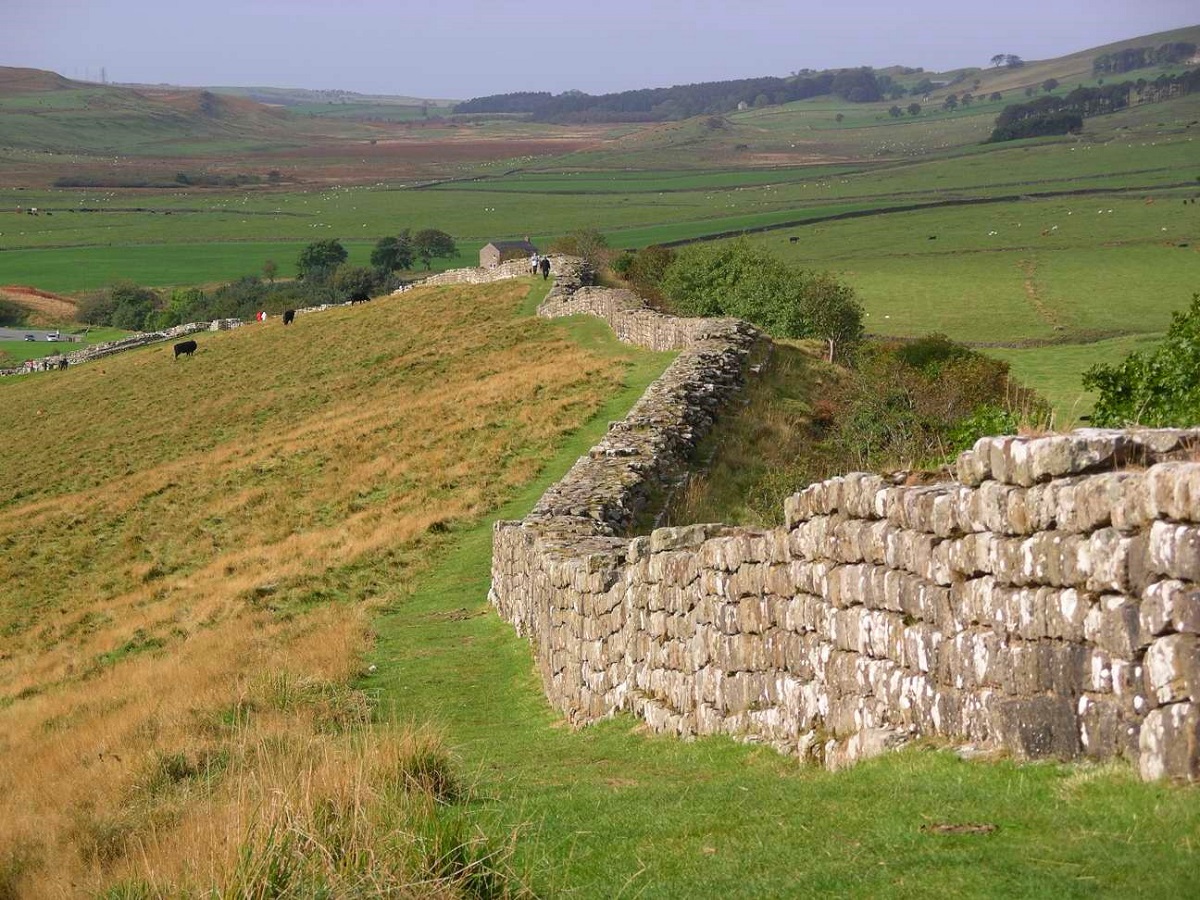
Hadrian’s Wall was an approximately 117 kilometer long Roman structure that was supposed to protect the northern border of the Roman Empire in the province of Brittania against Caledonia in the Scottish area. The wall was established from present-day Wallsend in the east on the River Tyne to Bowness-on-Solway in the west, and was named after the Emperor Hadrian, who began construction in the year 122.
The fortress functioned by stationing soldiers along the wall in both larger forts, smaller forts every Roman mile and in fortified towers. That way, the Romans could monitor the border across the entire island. There were also gates in Hadrian’s Wall for passengers and presumably also customs clearance of goods.
No parts of Hadrian’s Wall have been preserved in full height, as the stones were used to build houses and roads after the Roman era. However, there are quite a few excavations of the wall and fortified places along it that you can see. They give an impression of the great Roman work, and you can follow the Hadrian’s Wall Trail, which is a walking route that largely follows the old wall.
After Hadrian’s death in 138, Antoninus Pius became emperor, and he started construction of the so-called Antonine Wall approximately 160 kilometers north of Hadrian’s Wall, which was almost abandoned on the same occasion. When Marcus Aurelius became emperor in 161, he again recognized Hadrian’s Wall as a border, and thereby the wall came back into use. The wall was used until the fourth century, when the British used parts of it after the Roman withdrawal from Britannia.
Dalton Park, Murton, Seaham
dalton-park.co.uk
Percy Street
eldon-garden.co.uk
Eldon Square
intu.co.uk/eldonsquare
Eldon Square
johnlewis.com
Gateshead
intu.co.uk/metrocentre
Coble Dene, North Shields
royalquaysoutletcentre.com
Coast Road, Wallsend
silverlinkshoppingpark.co.uk
Grey Street, Grainger Street, Northumberland Street, Stowell Street
Grainger Market
Life Science Centre
Times Square
life.org.uk
Great North Museum
Hancock, Barras Bridge
greatnorthmuseum.org.uk
Beamish Museum
Beamish
beamish.org.uk
Tynemouth Aquarium
Grand Parade, Tynemouth
tynemouthaquarium.co.uk
Discovery Museum
Blandford Square
discoverymuseum.org.uk
Newcastle United
St. James’ Park, Strawberry Place
nufc.co.uk
NELSAM
Old Washington Road, Sunderland
nelsam.org.uk
Stephenson Railway Museum
Middle Engine Lane, North Shields
stephensonrailwaymuseum.org.uk
Newcastle’s history begins with the Roman construction of the fort Pons Aelius in connection with the construction of Emperor Hadrian’s Wall from the year 122. The wall was to protect against the Scots in the north, and an actual settlement developed around some of the forts, including Pons Aelius, which had about 2,000 inhabitants.
After the Roman withdrawal from England, Pons Aelius and the Newcastle area became part of the Anglo-Saxon kingdom of Northumbria. The city became known during this time with the name Monkchester, but it did not have a very long life. Danish Vikings attacked the region many times, and there were local uprisings as well. Monkchester was destroyed and ended its history as a city.
In 1080, the English king, William the Conqueror, built a new castle on the site, hence the name Newcastle. Throughout the Middle Ages, Newcastle constituted the north-east defenses of England. In addition to the castle, city walls were also built, so it was a difficult to conquer city, which was also important due to the many border wars against Scotland. In 1174, the Scottish king, William I Lion, was taken prisoner in Newcastle, and through the 14th century, attacking Scots were defeated three times.
In the 16th century, Newcastle began to flourish greatly. The threat from Scotland was gradually gone, and in 1530 the town gained a monopoly in the area on the shipment of coal, which brought with it a great deal of trade. It was not least due to this monopoly that the rivalry between Newcastle and nearby Sunderland started.
During the English Civil War in the middle of the 17th century, Newcastle was on the king’s side, and the city was attacked by Parliament and its supporters, who had a number of Scots, who thereby returned to the city. The English king ended up being imprisoned by the Scots in Newcastle in the period 1646-1647, and the outcome of the war was in favor of the parliament.
During the 18th century, not least the printing presses and glassworks grew in size, and through the century they became among the largest in England and for glass in the whole world. However, it was still the coal trade that was the city’s most lucrative source of income.
In the 19th century, the Newcastle area became the industrial locomotive of the area. It was especially the shipbuilding industry and general heavy industry that created many jobs and thereby the city attracted lots of new inhabitants. Among the known products of the time are Robert Stephenson’s locomotive, Rocket, and Charles Parson’s invention of the steam turbine.
It was also in the 19th century that the city’s current center was conceived. It was primarily Richard Grainger and John Dobson who laid out and implemented the city plans with partial demolition of old buildings to make room for wider streets and larger magnificent buildings, as can be seen in Gray Street, among other places. The city was also located on the London-Edinburgh railway line, and bridges were therefore built across the Tyne River. They continue with their rustic iron constructions to be symbols of the industrial age through the late 1800s and early 1900s.
In the latter half of the 20th century, part of Richard Grainger’s Grainger Town district has been redeveloped. It has provided space for modern buildings, shopping malls and administration centers. In recent years, part of the development has been concentrated on the former port areas along Tyne River. Cultural offerings, beautiful promenades and buildings with even very exciting modern architecture have been developed, so now locals and tourists can on a short walk view both the city’s old and new monuments.
 Newcastle, England[/caption]
Newcastle, England[/caption]
Overview of Newcastle
Newcastle is a city in northern England, and it an interesting mix of new and old. The remains of the old castle that gave the city its name and the preserved parts of the medieval city wall are the most striking examples from history. Modern museums, well-stocked shopping malls and innovative architecture are also part of Newcastle.
Along the Tyne River there are several majestic bridges, and along the landscaped river promenade you can see some of these masterpieces from the industrial age, that added to Newcastle and northern England fame. In the same area, you can see some of England’s most spectacular buildings from recent decades.
About the Whitehorse travel guide
Contents: Tours in the city + tours in the surrounding area
Published: Released soon
Author: Stig Albeck
Publisher: Vamados.com
Language: English
About the travel guide
The Whitehorse travel guide gives you an overview of the sights and activities of the Canadian city. Read about top sights and other sights, and get a tour guide with tour suggestions and detailed descriptions of all the city’s most important churches, monuments, mansions, museums, etc.
Whitehorse is waiting for you, and at vamados.com you can also find cheap flights and great deals on hotels for your trip. You just select your travel dates and then you get flight and accommodation suggestions in and around the city.
Read more about Whitehorse and Canada
Canada Travel Guide: https://vamados.com/canada
City tourism: https://visitwhite-horse.ca
Main Page: https://www.vamados.com/
Buy the travel guide
Click the “Add to Cart” button to purchase the travel guide. After that you will come to the payment, where you enter the purchase and payment information. Upon payment of the travel guide, you will immediately receive a receipt with a link to download your purchase. You can download the travel guide immediately or use the download link in the email later.
Use the travel guide
When you buy the travel guide to Whitehorse you get the book online so you can have it on your phone, tablet or computer – and of course you can choose to print it. Use the maps and tour suggestions and you will have a good and content-rich journey.


The Baltic Center for Contemporary Art is one of Newcastle’s cultural strongholds, located in the old industrial building, Baltic Flour Mills. The center has been located here since 2002, and on the many floors there is always a great variety in exhibitions and events.
Baltic Flour Mills was built by Joseph Rank from the 1930s until the completion and opening of the mill in 1950. It was a large and well-known workplace and the building could hold 22,000 tons of grain. Baltic Flour Mills closed in 1976 and the silos were used for another eight years. They then wanted to preserve the industrial landmark in the city.
The Theater Royal is Newcastle’s stately theater royal, part of Richard Grainger’s grand 1830s town plan that established Grainger Town along Gray Street as a modern part of a newly developed Newcastle.
One of the major new buildings that came to define Newcastle was the Theater Royal, designed by local architects John and Benjamin Green. The theater opened in 1837, and the first production was The Merchant of Venice.

The Glasshouse is a steel and glass building that stands as a modern landmark on the south bank of the River Tyne. The building is distinctive, and its round shapes lie like one of nature’s creations and form the framework for a center for music with three stages.
The venue opened in 2004 under the name Sage Gateshead. It happened after there had been plans for a new concert hall since the 1990s. An architectural competition was launched and Foster and Partners’ proposal for Newcastle’s cultural spearhead was chosen.
Grainger Market is a series of covered market halls that were built in the 1830s, where they wanted to gather the market activities centrally in the city. Thereby, the new market building replaced, among other things, markets along Gray Street.
The market halls were designed by John Dobson and Grainger Market has two sections. The Eastern Market was a meat market that was built with long corridors, while the Western Market was a vegetable market with a large open hall.
Blackfriars is a Dominican monastery in Newcastle, founded by the wealthy merchant Sir Peter Scott in the 13th century, when various monastic orders began to come to England. The site was run as a monastery until the Reformation in the 1530s, when all monasteries were dissolved under King Henry VIII.
After the dissolution, the abbey was acquired by the city of Newcastle, who leased it to nine of the city’s lairds, who remodeled the old buildings. The Lows used the complex as a meeting place until the 1800s, when it fell into disrepair. The city bought the site in the 1950s, and the old monastery was restored between 1973 and 1981.
Today there are a few preserved monastery buildings, but the Dominicans’ church and monastery yard no longer exist. The church was demolished in the 16th century and its outline is marked in the grass in the open area. There is also an exhibition about the history of Blackfriars, workshops and a restaurant here.
Chinatown is the name of the Chinese quarter in Newcastle. The area arose when the city’s Chinese population gathered their urban life over time around the streets that today make up the city’s Chinatown, and in this area there used to be a monastery.
At the northern entrance to St. Andrew’s Street you can see a traditional Chinese portal that has stood as a symbol of Chinatown since 2004. From here you can take a walk in the district and along the main street Stowell Street, at the southern end of which you can see a preserved part of Newcastle’s old city wall.
Newcastle Town Wall is a medieval town wall that was built in the 13th and 13th centuries as protection for the city during troubled times. The wall was up to 7.6 meters high and over 2 meters thick in its approximately 3 kilometer length around what was then Newcastle.
There were six gates in the city wall, the Close Gate, the West Gate, the New Gate, the Pilgrim Gate, the Pandon Gate, and the Sand Gate, and in addition there were seventeen towers. The wall came into use, and in the middle of the 17th century Scots managed to penetrate it during the English Civil War.
Newcastle’s city wall had become redundant in the 18th century, and over time large parts of the wall were torn down in connection with the city’s natural development. However, a large preserved section of the western wall can still be seen in and around W Walls, Stowell Street and Orchard Street.

The Cathedral Church of St Mary or simply St Mary’s Cathedral is Newcastle’s Roman Catholic cathedral. As a cathedral, the cathedral is the seat of the Bishop of Hexham and Newcastle, and it gained that status in 1850 as the first church in Newcastle.
The cathedral was built in the years 1842-1844 by the architect Augustus Welby Pugin, who is known for several Neo-Gothic buildings such as the Elizabeth Tower and the interior of Westminster in London. It was also Pugin who designed the church’s mosaic windows, which were produced by William Wailes in 1843.
Similar to Newcastle Travel Guide
